英语语言学 社会语言学 Sociolinguistics
- 格式:ppt
- 大小:95.50 KB
- 文档页数:37
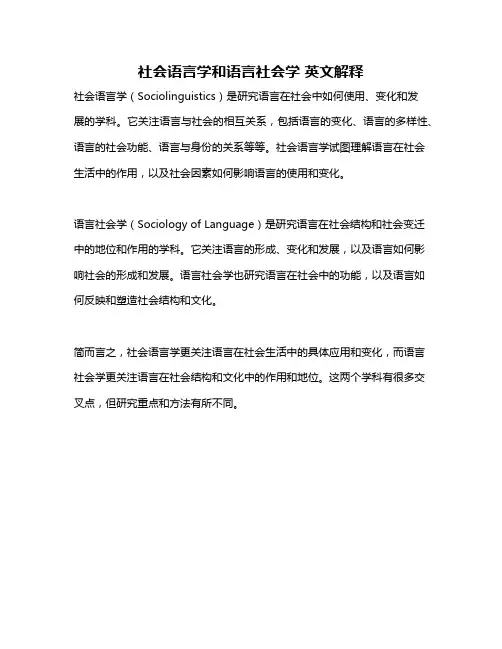
社会语言学和语言社会学英文解释
社会语言学(Sociolinguistics)是研究语言在社会中如何使用、变化和发
展的学科。
它关注语言与社会的相互关系,包括语言的变化、语言的多样性、语言的社会功能、语言与身份的关系等等。
社会语言学试图理解语言在社会生活中的作用,以及社会因素如何影响语言的使用和变化。
语言社会学(Sociology of Language)是研究语言在社会结构和社会变迁中的地位和作用的学科。
它关注语言的形成、变化和发展,以及语言如何影响社会的形成和发展。
语言社会学也研究语言在社会中的功能,以及语言如何反映和塑造社会结构和文化。
简而言之,社会语言学更关注语言在社会生活中的具体应用和变化,而语言社会学更关注语言在社会结构和文化中的作用和地位。
这两个学科有很多交叉点,但研究重点和方法有所不同。
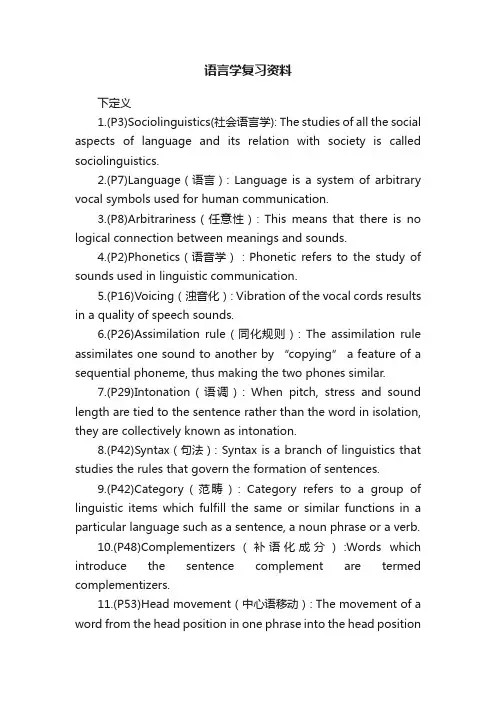
语言学复习资料下定义1.(P3)Sociolinguistics(社会语言学): The studies of all the social aspects of language and its relation with society is called sociolinguistics.2.(P7)Language(语言): Language is a system of arbitrary vocal symbols used for human communication.3.(P8)Arbitrariness(任意性): This means that there is no logical connection between meanings and sounds.4.(P2)Phonetics(语音学):Phonetic refers to the study of sounds used in linguistic communication.5.(P16)Voicing(浊音化): Vibration of the vocal cords results in a quality of speech sounds.6.(P26)Assimilation rule(同化规则): The assimilation rule assimilates one sound to another by “copying” a feature of a sequential phoneme, thus making the two phones similar.7.(P29)Intonation(语调): When pitch, stress and sound length are tied to the sentence rather than the word in isolation, they are collectively known as intonation.8.(P42)Syntax(句法): Syntax is a branch of linguistics that studies the rules that govern the formation of sentences.9.(P42)Category(范畴): Category refers to a group of linguistic items which fulfill the same or similar functions in a particular language such as a sentence, a noun phrase or a verb.10.(P48)Complementizers(补语化成分):Words which introduce the sentence complement are termed complementizers.11.(P53)Head movement(中心语移动): The movement of a word from the head position in one phrase into the head positionin another is known as head movement.12.(P64-65)Linguistic context(语言语境): The linguistic context is concerned with the probability of a word’s co-occurrence or collocation with another word.13.(P66)Reference(所指): Reference means what a linguistic form refers to in the real, physical world.14.(P70)Relational opposites(关系反义词): Pairs of words that exhibit the reversal of a relationship between the two items are called relational opposites.15.(P74)Argument(论元): An argument is a logical participant in a predication, largely identical with a nominal element in a sentence.16.(P77)Pragmatics(语用学): Pragmatics is the study of how speakers of a language use sentences to effect successful communication.17.(P81)Constatives(表述句): Constatives are statements that either state or describe, and are thus verifiable.填空题第一章1. (P3) If a linguistic aims to describe and analyze the language people actually use, it is said to be descriptive(描写性的). If the linguistic study aims to lay down rules for “correct and standard” behavior in using language, it is said to be prescriptive(规定性的).2.(P4) The description of a language at some point of time in history is a synchronic(共时的)study; the description of a language as it changes through time isa diachronic(历时的)study.3.(P4) Langue(语言)refers to the abstract linguistic system shared by all the members of a speech community, and parole(言语)refers to the realization of language in actual use4. (P5) Chomsky defines competence(语言能力)as the ideal user’s knowledge of the rules of his language, and performance (语言表现)the actual realization of his knowledge in linguistic communication.第二章5.(P17)As some speech sounds produced differ only in some detailed aspects, the IPA provides its users with another set of symbols called diacritics(发音符号/辨音符)6. (P23) A phoneme(音素)is a phonological unit, it is a unit that is of distinctive value, it is an abstract value.7. (P24) It can be easily observed that phonetically similar sounds might be related in two ways. If they are two distinctive phonemes,they are said to form a phonemic contrast(音素对照),e.g. /p/ and /b/ in [pit] and [bit].8. (P24)When two different forms are identical in every way except for one sound segment which occur the same position in the strings, the two sound combinations are said to from a minimal pair(最小配对).e.g pill and bill, pill and till are a minimal pair.9.(P25) Rules that govern the combination of sounds in a particular language, the rules are called sequential rules(序列规则).10.(P27) The phonemic features that occur above the level of the segments are called suprasegmental feature(超音段特征).第三章11.(P33)Morpheme(词素): the smallest unit of language that carries information about meaning or function.A morpheme which can be a word by itself is called a free morpheme(自由词素). Whereas a morpheme that must beattached to another one is called bound morpheme(粘着词素).12.(P33) The variant forms of a morpheme are called its allomorphs(词素变体).第四章13. (P44) Syntactic units that are built around a certain word category are called phrases(短语), the category of which is determined by the word category around which the phrase is built.14. (P45)Phrases that are formed of more than one word usually contain the following elements: head(中心语), specifier(标志语)and complement(补语).15. (P48)The information about a word’s complement is included in the head andtermed subcategorization(次范畴化).16. (P52) Transformation(转换)is a special type of rule that can move an element from one position to another.第五章17. (P67-68)Synonymy:近义关系的分类:1) Dialectal synonyms(方言同义词)-- synonyms used in different regional dialects.(来自不同地域的人使用同一种语言产生的不同)2) Stylistic synonyms(文体同义词) -- synonyms differing in style3) Synonyms that differ in their emotive or evaluative(评价) meaning4) Collocational synonyms(搭配同义)5) Semantically different synonyms(不考)18.(P69) When two words are identical in sound, they are homophones(同音不同形不同义). When two words are identical in spelling, they are homographs(同形不同音不同义). When twowords are identical in both sound and spelling, they are complete homonyms(同形同音不同义).19. (P70) Antonymy:反义关系的分类1) Gradable antonyms(可分等级的反义词)2) Complementary antonyms(互补反义词)3) Relational opposites(关系反义词)20.(P72) Componential analysis(成分分析)is a way proposed by the structural semanticists to analyze word meaning. The approach is based upon the belief that the meaning of a word can be dissected into meaning components, called semantic features.第六章21. (P81)Three Speech Acts:三种言语行为According to Austin new model, a speaker might be performing three acts simultaneously when speaking:locutionary act(言内行为), illocutionary act(言外行为), and perlocutionary act(言后行为).22.(P90)Pragmatic failure(语用失误) occurs when the speaker fails to use language effectively to achieve a specific communicative purpose, or when the hearer fails to recognize the intention or the illocutionary(言外之意) force of the speaker’s utterance in the context of c ommunication.第八章23.(P111) Speech variety(言语变体), or language variety, refers to any distinguishable form of speech used by a speaker or a group of speakers.24. (P117) Halliday further distinguishes three social variables(语域三变量)that determine the register: field of discourse(语场), tenor of discourse(语旨), and mode of discourse(语式).25. (P122) The term diglossia(双言制度) refers to a sociolinguistic situation similar to bilingualism where two varieties of a language exist side by side throughout the community, with each having a definite role to play.上一页下一页。
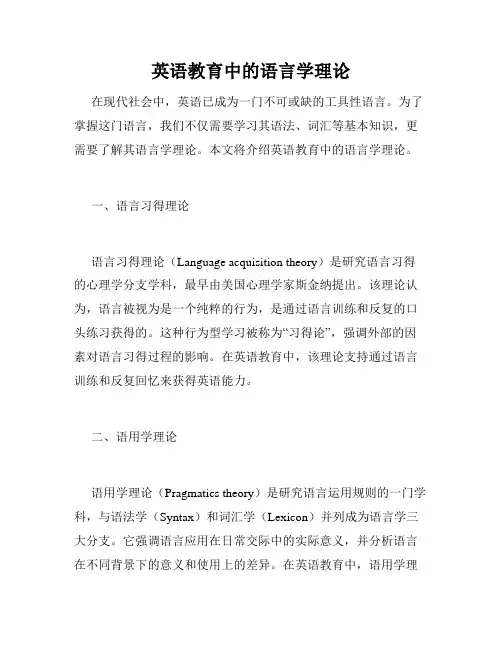
英语教育中的语言学理论在现代社会中,英语已成为一门不可或缺的工具性语言。
为了掌握这门语言,我们不仅需要学习其语法、词汇等基本知识,更需要了解其语言学理论。
本文将介绍英语教育中的语言学理论。
一、语言习得理论语言习得理论(Language acquisition theory)是研究语言习得的心理学分支学科,最早由美国心理学家斯金纳提出。
该理论认为,语言被视为是一个纯粹的行为,是通过语言训练和反复的口头练习获得的。
这种行为型学习被称为“习得论”,强调外部的因素对语言习得过程的影响。
在英语教育中,该理论支持通过语言训练和反复回忆来获得英语能力。
二、语用学理论语用学理论(Pragmatics theory)是研究语言运用规则的一门学科,与语法学(Syntax)和词汇学(Lexicon)并列成为语言学三大分支。
它强调语言应用在日常交际中的实际意义,并分析语言在不同背景下的意义和使用上的差异。
在英语教育中,语用学理论为学生了解英语在不同场合下的使用和语气、联想等方面提供了重要的指导。
三、认知语言学理论认知语言学理论(Cognitive Linguistics)是一种新兴的语言学派别,它探讨语言与思维之间的关系,研究语言知识的认知和构建方式。
该理论认为,语言的意义是由认知语言处理机制产生的,语言的规律来自于认知建构活动。
在英语教育中,认知语言学理论强调学习者将语言的概念与自己的认知结构进行联系,从而更好地理解和掌握语言。
四、社会语言学理论社会语言学理论(Sociolinguistics)分析语言在社会上的使用和使用者的社会环境的影响。
社会语言学理论强调文化和社会因素对语言使用的影响,并研究它们如何影响书面和口头语言的发展。
在英语教育中,社会语言学理论可以帮助学生了解不同文化背景和社会环境对语言的影响,更加深入地了解和运用语言。
总之,语言学理论可以为我们更好地理解和掌握英语提供帮助。
作为英语学习者,我们应该不断更新自己对语言学理论的知识,并将其运用到实际学习当中。
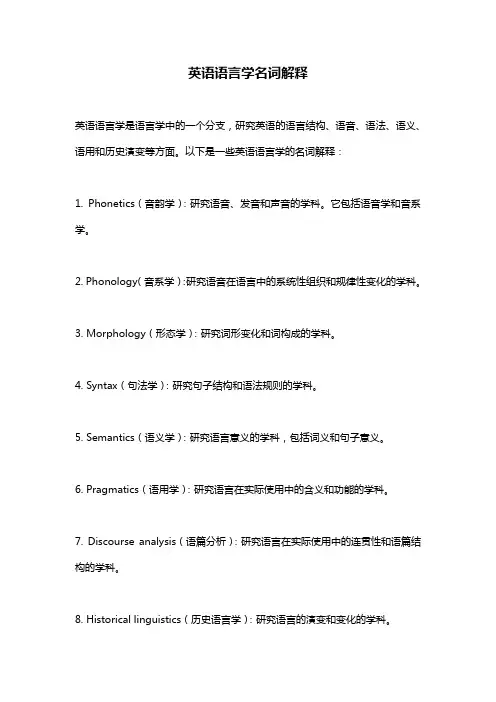
英语语言学名词解释
英语语言学是语言学中的一个分支,研究英语的语言结构、语音、语法、语义、语用和历史演变等方面。
以下是一些英语语言学的名词解释:
1. Phonetics(音韵学):研究语音、发音和声音的学科。
它包括语音学和音系学。
2. Phonology(音系学):研究语音在语言中的系统性组织和规律性变化的学科。
3. Morphology(形态学):研究词形变化和词构成的学科。
4. Syntax(句法学):研究句子结构和语法规则的学科。
5. Semantics(语义学):研究语言意义的学科,包括词义和句子意义。
6. Pragmatics(语用学):研究语言在实际使用中的含义和功能的学科。
7. Discourse analysis(语篇分析):研究语言在实际使用中的连贯性和语篇结构的学科。
8. Historical linguistics(历史语言学):研究语言的演变和变化的学科。
9. Sociolinguistics(社会语言学):研究语言和社会、文化、地理和历史等因素之间的关系的学科。
10. Psycholinguistics(心理语言学):研究语言和心理过程之间的关系的学科,包括语言习得、记忆和理解等。
以上是一些常见的英语语言学名词解释,它们涵盖了英语语言学的主要领域和分支。
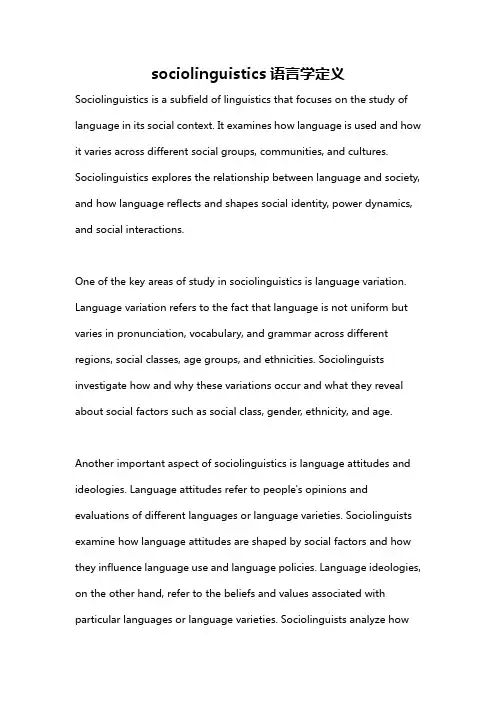
sociolinguistics语言学定义Sociolinguistics is a subfield of linguistics that focuses on the study of language in its social context. It examines how language is used and how it varies across different social groups, communities, and cultures. Sociolinguistics explores the relationship between language and society, and how language reflects and shapes social identity, power dynamics, and social interactions.One of the key areas of study in sociolinguistics is language variation. Language variation refers to the fact that language is not uniform but varies in pronunciation, vocabulary, and grammar across different regions, social classes, age groups, and ethnicities. Sociolinguists investigate how and why these variations occur and what they reveal about social factors such as social class, gender, ethnicity, and age.Another important aspect of sociolinguistics is language attitudes and ideologies. Language attitudes refer to people's opinions and evaluations of different languages or language varieties. Sociolinguists examine how language attitudes are shaped by social factors and how they influence language use and language policies. Language ideologies, on the other hand, refer to the beliefs and values associated with particular languages or language varieties. Sociolinguists analyze howlanguage ideologies influence language choices, language maintenance or shift, and language planning.Sociolinguistics also explores language and identity. Language is a fundamental aspect of individual and group identity, and sociolinguists investigate how language use and language choices contribute to the construction and negotiation of social identities. Language can be a marker of social class, ethnicity, gender, and other social categories, and sociolinguists examine how language is used to express and negotiate these identities.Power and language is another important area of study in sociolinguistics. Language is not only a means of communication but also a tool of power and social control. Sociolinguists investigate how language is used to assert dominance, maintain social hierarchies, and reproduce inequalities. They examine how language choices and language policies can reflect and perpetuate power imbalances and social inequalities.Sociolinguistics also examines language change and language contact. Language is constantly evolving, and sociolinguists study how and why languages change over time. They investigate the social factors thatdrive language change, such as contact with other languages, migration, and social mobility. Sociolinguists also analyze language contact situations, where different languages come into contact and influence each other, leading to the emergence of new linguistic varieties.In addition to these main areas of study, sociolinguistics also explores language and education, language planning and policy, language and globalization, and language and technology. Sociolinguists investigate how language is taught and learned in educational settings, how language policies are formulated and implemented, how language is affected by globalization processes, and how technology impacts language use and communication.Overall, sociolinguistics provides valuable insights into the complex relationship between language and society. It helps us understand how language is used, how it varies, and how it reflects and shapes social identities, power dynamics, and social interactions. By studying sociolinguistics, we can gain a deeper understanding of the role of language in our everyday lives and in the broader social context.。
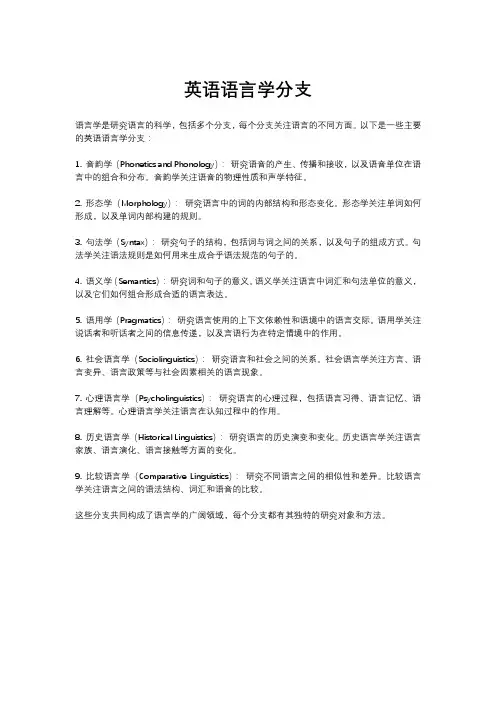
英语语言学分支语言学是研究语言的科学,包括多个分支,每个分支关注语言的不同方面。
以下是一些主要的英语语言学分支:1. 音韵学(Phonetics and Phonology):研究语音的产生、传播和接收,以及语音单位在语言中的组合和分布。
音韵学关注语音的物理性质和声学特征。
2. 形态学(Morphology):研究语言中的词的内部结构和形态变化。
形态学关注单词如何形成,以及单词内部构建的规则。
3. 句法学(Syntax):研究句子的结构,包括词与词之间的关系,以及句子的组成方式。
句法学关注语法规则是如何用来生成合乎语法规范的句子的。
4. 语义学(Semantics):研究词和句子的意义。
语义学关注语言中词汇和句法单位的意义,以及它们如何组合形成合适的语言表达。
5. 语用学(Pragmatics):研究语言使用的上下文依赖性和语境中的语言交际。
语用学关注说话者和听话者之间的信息传递,以及言语行为在特定情境中的作用。
6. 社会语言学(Sociolinguistics):研究语言和社会之间的关系。
社会语言学关注方言、语言变异、语言政策等与社会因素相关的语言现象。
7. 心理语言学(Psycholinguistics):研究语言的心理过程,包括语言习得、语言记忆、语言理解等。
心理语言学关注语言在认知过程中的作用。
8. 历史语言学(Historical Linguistics):研究语言的历史演变和变化。
历史语言学关注语言家族、语言演化、语言接触等方面的变化。
9. 比较语言学(Comparative Linguistics):研究不同语言之间的相似性和差异。
比较语言学关注语言之间的语法结构、词汇和语音的比较。
这些分支共同构成了语言学的广阔领域,每个分支都有其独特的研究对象和方法。

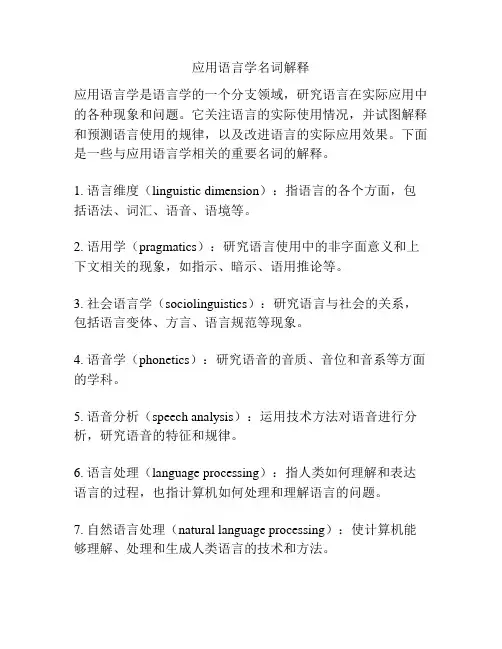
应用语言学名词解释应用语言学是语言学的一个分支领域,研究语言在实际应用中的各种现象和问题。
它关注语言的实际使用情况,并试图解释和预测语言使用的规律,以及改进语言的实际应用效果。
下面是一些与应用语言学相关的重要名词的解释。
1. 语言维度(linguistic dimension):指语言的各个方面,包括语法、词汇、语音、语境等。
2. 语用学(pragmatics):研究语言使用中的非字面意义和上下文相关的现象,如指示、暗示、语用推论等。
3. 社会语言学(sociolinguistics):研究语言与社会的关系,包括语言变体、方言、语言规范等现象。
4. 语音学(phonetics):研究语音的音质、音位和音系等方面的学科。
5. 语音分析(speech analysis):运用技术方法对语音进行分析,研究语音的特征和规律。
6. 语言处理(language processing):指人类如何理解和表达语言的过程,也指计算机如何处理和理解语言的问题。
7. 自然语言处理(natural language processing):使计算机能够理解、处理和生成人类语言的技术和方法。
8. 语料库语言学(corpus linguistics):以语料库为基础,运用统计方法研究语言的现象和规律。
9. 语篇分析(discourse analysis):研究语言在实际语境中的使用和组织方式,关注语言与社会、文化、认知等因素的关系。
10. 语境(context):指在特定的交际环境中,语言使用者通过语言实际传递的意义。
11. 二语习得(second language acquisition):指学习第二语言的过程和结果的研究。
12. 交际(communication):指人类通过语言实现信息传递和意义交流的过程。
13. 言语行为(speech act):指通过语言行动来实现特定目的的行为,如请求、命令、承诺等。
14. 修辞学(rhetoric):研究通过语言来实现说服、感染等目的的技巧和方法。
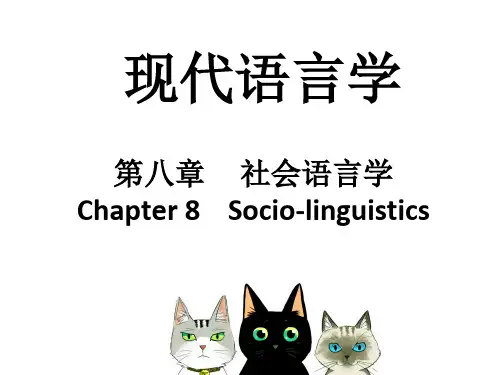

Chapter 8 Language and society语言和社会知识点:1.*Definition: sociolinguistics; regional dialect; sociolect; idiolect; ReceivedPronunciation2.Relatedness between language and society3.*Varieties of language4.*Halliday’s register theory5.Degree of formality6.Standard Dialect7.# Pidgin and Creole8.*#Bilingualism vs. diglossia考核目标:识记:*Definition: sociolinguistics; regional dialect; sociolect; idiolect; Received Pronunciation领会:Relatedness between language and society; Varieties of language; Degree of formality; Degree of formality; Standard Dialect; Pidgin and Creole简单应用:Bilingualism vs. diglossia综合应用:Halliday’s register theory一、定义1.Sociolinguistics 社会语言学: is s the sub-field of linguistics that studies relation between language and society, between the ues of language and the social structures in which the users of lamguage live. 社会语言学是语言学中的一个次领域,它研究语言与社会的关系,以及语言的运用和语言使用者所在的社会结构之间的关系。

英语语言学专业术语英语语言学是研究英语语言的起源、发展、结构和使用的学科。
以下是常见的英语语言学专业术语及其解释。
1. Phonetics(音系学):研究语音的学科。
主要研究语音发音过程,包括语音的组成、发音方式和特点等。
2. Phonology(音韵学):研究语音在语言中的功能和规律的学科。
主要研究语音在不同语境下的变化规律和相互关系,包括音素、音位和音系等。
3. Morphology(形态学):研究语言中单词的形态和构成的学科。
主要研究单词的基本单位和构成规律,包括词根、词缀和词类等。
4. Syntax(句法学):研究句子结构和句子组成的学科。
主要研究句子的构成和排列方式,包括短语、从句和主谓结构等。
5. Semantics(语义学):研究语言意义的学科。
主要研究语言符号和意义之间的关系,包括单词、短语和句子的意义等。
6. Pragmatics(语用学):研究语言使用的学科。
主要研究语言与社会文化环境的关系,包括语境、语用规则和交际意图等。
7. Discourse analysis(话语分析):研究语篇结构和语篇功能的学科。
主要研究语言在话语交际中的组织和作用,包括话语行为、话语结构和话语分析方法等。
8. Sociolinguistics(社会语言学):研究语言和社会文化因素之间的关系和影响的学科。
主要研究不同社会群体、文化背景和地理区域中语言使用的差异和变化,包括方言、语言变体和语言政策等。
9. Psycholinguistics(心理语言学):研究语言和心理过程之间的关系的学科。
主要研究语言理解、语言产生和语言习得等心理过程,包括语音知觉、语法处理和语言记忆等。
以上是英语语言学常见的专业术语及其解释,希望能够帮助你更好地了解英语语言学。
社会语言学论文A Brief Analysis of Gender Differences in Language******学号:************院系:外国语学院班级:英语1101指导教师:***二〇一四年五月二十三日A Brief Analysis of Gender Differences in LanguageAbstractSociolinguistics is the descriptive study that concentrates on the study of how language is used, and the effects of language use on society. It also studies how language varieties differ between groups separated by certain social variables, for instance, ethnicity, religion, status, gender, level of education, etc. With regard to this paper, the emphasis will be put onto the differences in the actual speech of different gender. We can classify the gender differences in language into two categories. The first category is mainly about sexism in language, as for this category, we mainly focus on how speakers demonstrate their different cultural attitudes toward different genders. The second category is about the differences in the actual speech of men and women.In the first part, I will make a brief introduction about sociolinguistics and gender differences in language. In the second part, it will concern the categories of gender differences in language and previous study of gender differences in language. The third part concentrates on the approach of the analysis. The fourth is about the data collection and research methodology. The fifth part analyzes the differences of the speech between men and women from three perspectives— the purpose of the speech, the topic of the conversation and the mode of the speech. The final part comes to the conclusion about the gender differences in language.Key words: Gender differences, sociolinguistics, analysisMain Body1、IntroductionThe knowledge of gender differences in language is very helpful for language learners, and gender differences may exist not only one but all languages. Men and women, on average, tend to use slightly different language styles. These differences tend to be quantitative rather than qualitative. That is, to say that women make more minimal responses than men is akin to saying that men are taller than women. The initial identification of a women's register was by Robin Lakoff in 1975, who argued that the style of language served to maintain women's role in society. A later refinement of this argument was that gender differences in language reflected a power difference. However, both these perspective have the language style of men as normative, implying that women's style is inferior. More recently, Deborah Tannen has compared gender differences in language as more similar to 'cultural' differences. Comparing conversational goals, she argued that men have a report style, aiming to communicate factual information, whereas women have a rapport style, more concerned with building and maintaining relationships. Such differences are pervasive across mediums, including face-to-face conversation, written essays of primary school children, email, and even toilet graffiti. Communication styles are always a product of context, and as such, gender differences tend to be most pronounced in single-gender groups. One explanation for this, is that people accommodate their language towards the style of the person they are interacting with. Thus, in a mixed-gender group, gender differences tend to be less pronounced. A similarly important observation is that this accommodation is usually towards the language style, not the gender of the person. That is, a polite and empathic male will tend to be accommodated to on the basis of their being polite and empathic, rather than their being male.All in all, gender differences can be reflected in many aspects in our daily life, we should pay more attention to it, thus we can avoid many misunderstandings between men and women.2. Literature ReviewCategories of Gender Differences in LanguageAccording to Wolfson, the research about language and sex can be divided into two categories. The first category is about sexism in language and the ways in which speakers demonstrate their different cultural attitudes toward men and women. Two areas of sexism in English have been well-studied. One is that females are excluded from mention in English because the generic he/man problem. Men are regarded as the representatives of all human beings and their speech is the standard, while women are seen as inferior and secondary in society. The second is that females are give negative treatment in society. Bad words in our daily is always related to female words. Female words are often used to insult a male, whereas male words are usually used to compliment female.The second category is about the differences in the actual speech of men and women. The formation of these differences in language may have historical, physiological, social and psychological factors. Lakoff (1973) was one of the early articles to deal with the issue of differences in men’s and women’s speech. She has concluded six major characteristics of women’s speech: lexical choice, question intonation in statements, hedges which includes tag questions and statement modifiers which remove assertive force, emphatic modifiers and intonational emphasis, hypercorrect grammar and pronunciation and superpolite forms.3. Theoretical FrameworkThe contrast analysis of male and female language in daily conversation concerns many aspects, such as the topic of the conversation, the mode of the conversation and so on. The differences of the speech between men and women may result from their conception of value, their hobby and their interest etc. They hold different opinions according to the same matter. So we can refer to the ethnography of speaking in describing the gender differences in language. Ethnography refers to theinvestigation of cultures using a particular methodology, that of participant observation. The ethnography of speaking proposed by Dell Hymes in 1962.…The ethnography of speaking is concerned with the situations and uses, the patterns and functions, of speaking as an activity in its own right. (Hymes 1962:101) This ethnographic framework takes into account the various factors that are involved in speaking. An ethnography of a communicative event is a description of all the factors that are relevant in understanding how that particular communicative event achieves its objectives. (Wardhaugh1998)Conversation means to exchange ideas through interaction, so we can also employ the approach of interactional sociolinguistics—rapport talk proposed by Deborah Tannen (1984,1982) to analyze the gender differences in language. Tannen (1990a) has described the characteristics of men and women’s speech from nine dimensions: intimacy-independence, connection-status, inclusive-exclusive, relationship-information, rapport-report, community-contest, problems-solutions, novice-expert and listening-lecturing. From the description, we can conclude that women’s speech tends to be solidarity, yet men’s speech tends to be independent.4. Research MethodologyThere is a binary distinction between qualitative and quantitative research. Qualitative research is inductive, subjective, ungeneralisable, soft, process and verification oriented, hypothesis-driven, and hypothesis generating research, while quantitative research is deductive, objective, generalisable, hard, outcome and discovery oriented, data-driven and hypothesis testing research.In this paper, I employ the quantitative and descriptive methodology to discuss the differences of the speech between men and women. Firstly, the characteristics of women and men’s speech are collected. Secondly, the differences are described through the collection.5. Contrast Analysis of Speech of Men and Women in Daily ConversationThe speech of women differs from the speech of men in daily conversation. Men and women differ in the kinds of language they use because men and women often fill distinctly different roles in society. We can analyze the differences of the speech of men and women from many aspects, such as the purpose of the speech, the topics of the speech and the mode of the speech. Many of the differences may result from different socialization practices.5.1 The purpose of the conversationThe purpose of the women’s speech is to establish the rapport relationship among the members in the community. They try their best to become a member of the community. They want to keep intimate relationship through interaction. So in their speech, the main purpose is to express their feelings and listen to others. The style of their speech appears more obedient and negative.However, the purpose of men’s speech is task-oriented, they have a more analytical approach, so they try to solve problems and troubles through interaction. They seldom express their intimate feelings to others. They also want show their independence in the communication. So it is absolutely different from the purpose of the women’s conversation.5.2 The topic of the conversationThe topic of women’s conversation is different from that of men’s. The topic of the women’s conversation mainly concerns social life, emotion, this can not be separated from their position, profession, social status, and personality. Women’s speech is regarded as trivial and gossip-laden because in the speech community of women, they mainly discuss clothing, love, family, trifles in daily life, experience, emotion, food and drink, life’s troubles. The purpose of the speech is to show the intimate relationship with the addressees, and through the speech they want to reinforce their membership in the community.On the contrast, men show great interest in topics concerning business, politics, legal matters, sports, geography, economy and military etc., these aspects can reflect their solid position in society.6. ConclusionIt can never be denied that gender differences do exist in all languages. Since women and women play different role in social life, they will definitely employ the different skills or methods in their communication or conversation.Women’s speech is different from men’s speech in lexical choice, syntax and pragmatics in daily life. Like O’Barr and Atkins said, “women’s language ” would be more appropriately termed “powerless language”. It demonstrated to us that means this kind of language is less convincing, less intelligent, less competent, and less trustworthy, because women are more concerned about the emotion, intimacy, food, dress, relationship in conversation, they are always ready to share their happiness and sadness with people close to them or even strangers. However, men’s language is regarded as power because the controlling status in society, and what they are interested in is business, military, politics, sport and geography, they communicate with others in order to exchange ideas with them.After learned the sociolinguistics as well as this brief analysis of the gender differences in language, I came to realize that, as a language learner, we should not only learn the basic knowledge about language, but also know the culture of the language. What’s more, I realize that the gender differences in language can never be neglected in language learning for the essential role it plays.Reference1.Nessa Wolfson. Perspectiv e: Sociolinguistics and TESOL, Heinle & Heinle Publishers2.赵蓉晖.《语言与性别:口语的社会语言学研究》.上海外语教育出版社3.陈琳. 《英语中女性特点及其发展趋势探究》.《语文学刊》. 2010年第10期4.杨永林. 《社会语言学研究》.上海外语教育出版社20045.胡文仲.《超越文化的屏障》.外语教学与研究出版社。
社会语言学理论指导下的英语语言学习摘要:社会语言学是一门从社会的视角出发研究语言的学科。
在社会语言学理论指导下,英语语言学习者可以更好地了解英语文化、明确学习目的、开拓学习思路,实现用英语沟通的学习目标。
关键词:社会语言学理论文化学习网络语言社会语言学(Sociolinguistics )是美国语言学家哈佛·丘里(H.Currie )在1952年发表的论文《社会语言学的设计:语言和社会阶层的关系》( A Projection of Sociolinguistics:the Relationship of Speech to Social Status)中最先提出的。
之后,在1964年5月,美国召开首届社会语言学大会,会议论文集《社会语言学》在次年的出版标志着社会语言学的诞生。
社会语言学是研究语言与社会多方面关系的学科,它从不同社会科学(诸如社会学、人类学、民族学、心理学、地理学、历史学等)的角度去考察语言,探讨语言与社会的相互关系,突出交际能力,研究各种语言变异,揭示语言使用与文化因素之间的交互作用。
社会语言学理论研究同英语语言学习之间有着紧密的联系。
杨永林指出:首先,从理论借鉴角度看,美国社会语言学家Dell Hymes的交际教学法、拉波夫所首创的社会语言学变体理论等都为外语学习提供了借鉴;其次,Preston的《社会语言学与二语习得》、Wolfson的《多维视野:社会语言学与英语教学》等多部专著的出版充分证明了英语学习者必须考虑社会语言学这一影响语言学习的重要因素,必须充分运用社会语言学的理论、方法指导英语语言学习,才能起到事半功倍的效果。
一、社会语言学相对论理论指导学习范畴19世纪英国人类学家Edward Tylor在《原始文化》一书中指出,所谓文化乃是包括语言、信仰、艺术、道德、法律、习俗以及包括作为社会成员的个人而获得的其他任何能力、习惯在内的一种综合体。
无论哪一个国家或民族的文化,都具有相对于其他国家或民族不同的一些特征,也就是说文化的价值观、准则和信仰等必须为一个群体、一个社会的人们共同接受和遵循,即具有共享性,才能成为文化。